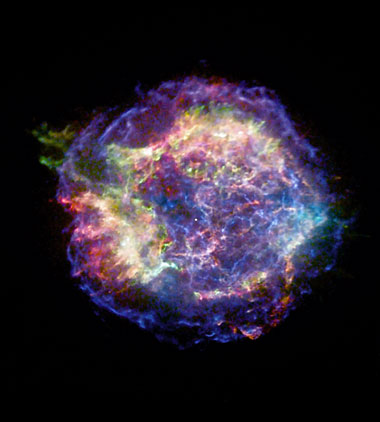|
Fly Through a Supernova Remnant in 3-D
When you look at a photo of a galaxy or nebula, do you wonder
what it would look like in 3-D? Astrophotos show objects in just
two dimensions on the plane of the sky, but everything out there
has depth. On Tuesday, astronomers presented new 3-D
animations that
blew my mind. The technique, developed from medical imaging
technology, will open new doors to scientific discovery.

The supernova remnant
Cassiopeia A, imaged in X-rays in 2007. Low-energy X-rays
are shown in red, intermediate energies in green, and high
energies in blue — the same way we see the different
wavelengths of visible light. Click for a larger still
image.
NASA / CXC / SAO /
D.Patnaude et al.
The images reveal unprecedented detail in one of the nearest and
youngest supernova remnants: Cassiopeia A. This nebula, X-ray
hot, is the tattered, expanding remains of a massive star that
exploded about 330 years ago (not including light-travel time;
Cas A is about 10,000 light-years distant). As the blast wave
expands outward, it sweeps up surrounding gas and dust in a
shock wave, the outer blue shell at right. This violent
interaction generates interesting physics, including the
magnetic acceleration of charged particles to nearly the speed
of light — the creation of cosmic rays.
But astronomers are also
keenly interested in using the remnant the way a police
detective uses a crime scene: to deduce what happened. The
expanding debris reveals vital clues about how the star
exploded, and what the star was like before.
Using observations from NASA’s infrared Spitzer
Space Telescope and Chandra
X-ray Observatory, along with ground-based
facilities, Tracey DeLaney (MIT Kavli Institute) and her
colleagues were able to reconstruct the 3-D structure of Cas A,
leading to movies
and animations that
let you see how the remnant would appear from different viewing
angles. It’s as if we could scoot around in a starship millions
of times faster than light (with no pesky effects of Einstein's
relativity) to inspect Cas A from all sides, or plunge
right through it.
To deduce depth as well as seeing width and breadth, the team
used various observations of the clouds, knots, and filaments of
different chemical compositions, along with information about
the velocity of these structures as they expand outward from the
explosion's center.
The resulting 3-D imagery makes it clear that the explosion had
two components. The star’s outer layers, which contained most of
its mass, were ejected in a spherical fashion, creating a round
blast wave. But the star’s inner core was blasted out in a
flattened plane, especially as high-velocity jets that may have
been directed along the progenitor’s rotation axis.
“Now we have to turn this data over to the theorists who
simulate supernova explosions and say, “Make this!” said DeLaney.
“We don’t understand how we get both the round and flat parts.”
The technology that made this research possible was originally
developed at Brigham and Women’s Hospital in Boston to help
doctors create and roam around 3-D images inside the human body.
Alyssa Goodman (Harvard-Smithsonian Center for Astrophysics)
acquired the software and helped adapt it for astronomical
purposes. She now leads a group known as the Astronomical
Medicine Project. The group has created a
reconstruction of a star-forming gas cloud as the first
manipulable 3-D image published in a scientific journal; watch
their demonstration on
YouTube.
Using four Chandra images taken in 2000, 2002, 2004, and 2007, a
team led by Daniel Patnaude (Harvard-Smithsonian Center for
Astrophysics) made an animation showing
the small but obvious expansion of Cas A from year to year.
(Here are all
versions,including zoom-ins.)
The series of images show the outer shock wave to be traveling
4,900 kilometers per second (11 million miles per hour). As fast
as this sounds, it’s actually a bit slower than the predicted
speed of 6,300 km/sec based on the explosion’s total deduced
energy. Patnaude thinks that the blast wave has been dissipating
energy along the way as embedded magnetic fields accelerate
charged particles (cosmic
rays) to nearly to the speed of light.
“These results suggest that about 35% of the energy of the
supernova remnant has to go into the acceleration of cosmic
rays,” says Patnaude. This deduction, along with other X-ray
observations from other satellites, indicates that most of the
low-energy cosmic rays that ceaselessly bombard Earth come from
supernova remnants.
“This is really exciting stuff,” says Robert Petre (NASA/Goddard
Space Flight Center), an expert in supernova remnants who is not
part of the team. Goodman adds, “This is Harry Potteresque to
me, we’re bringing still pictures to life. This is the future of
electronic publishing.”
For more, see this Chandra
press release.
Source: http://www.skyandtelescope.com/news/37234169.html
1 2 3 4 5 6 7 8 9 10 Newest
articles
|

